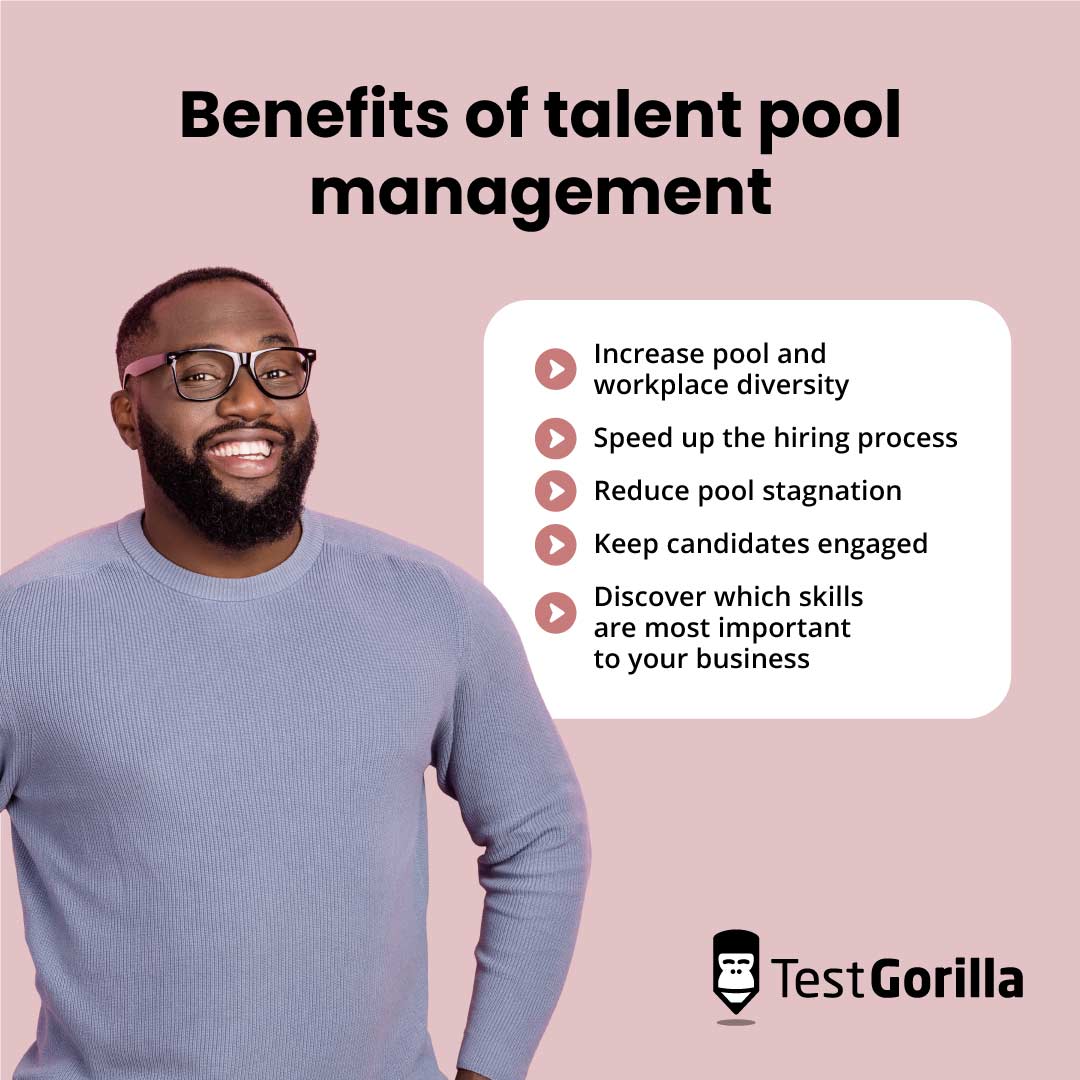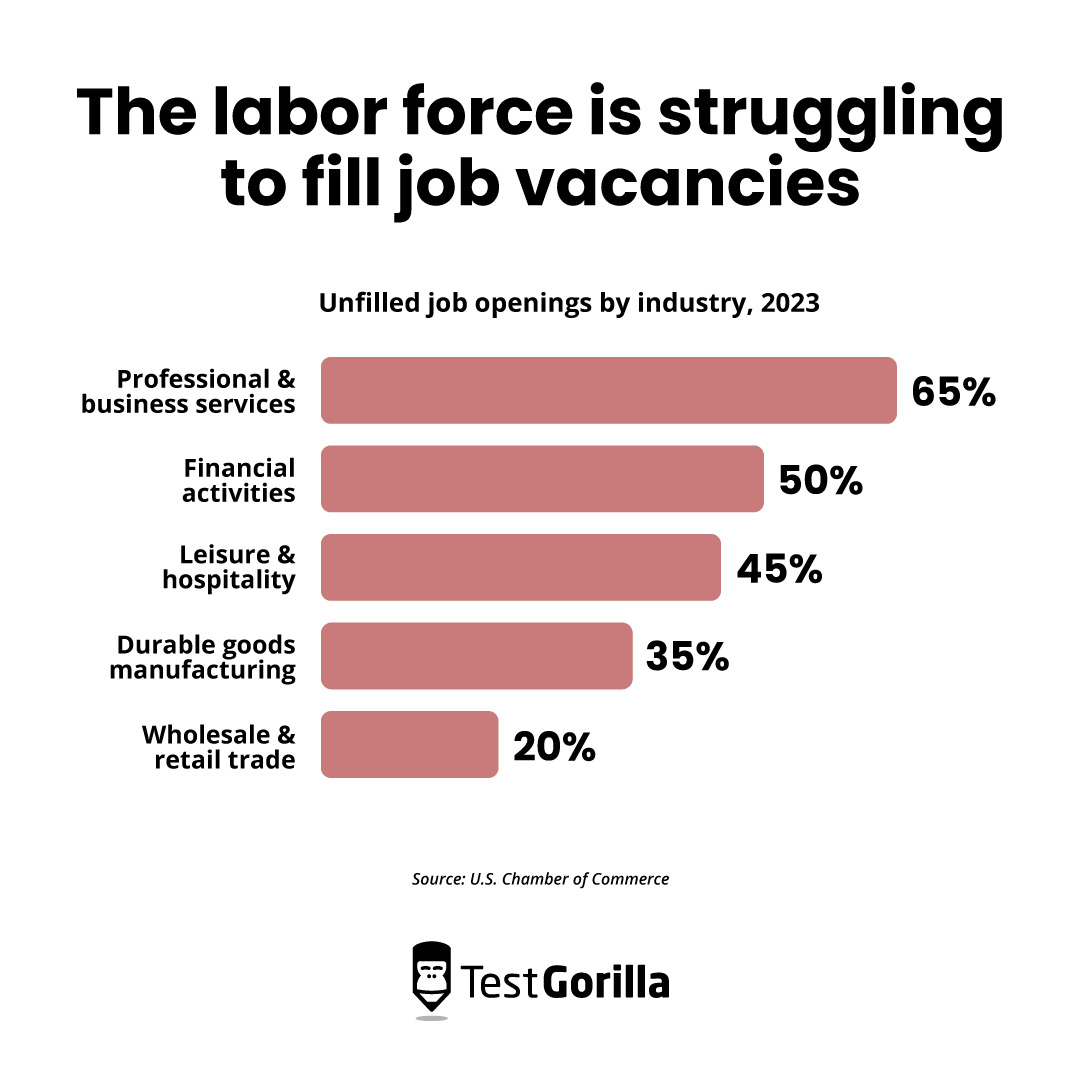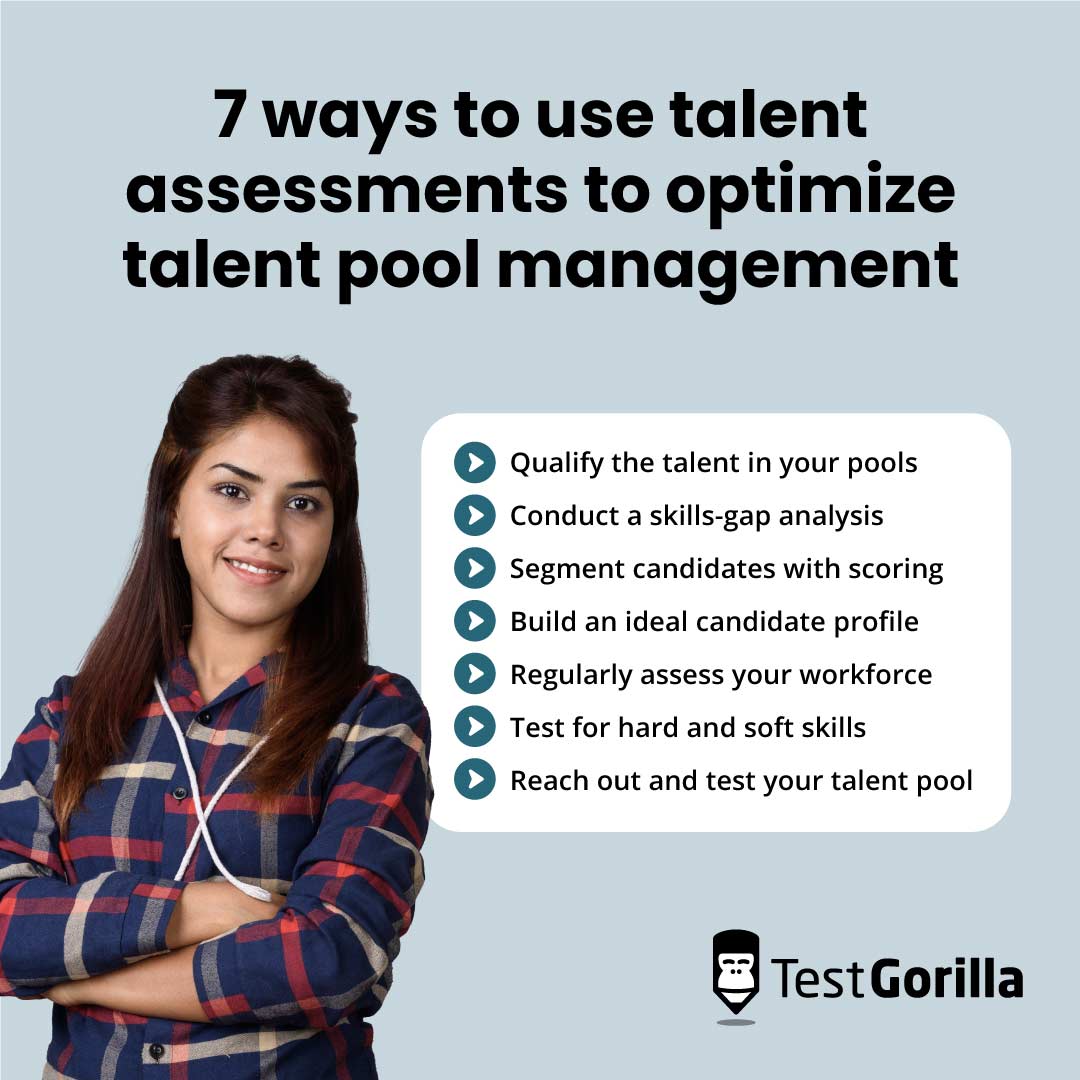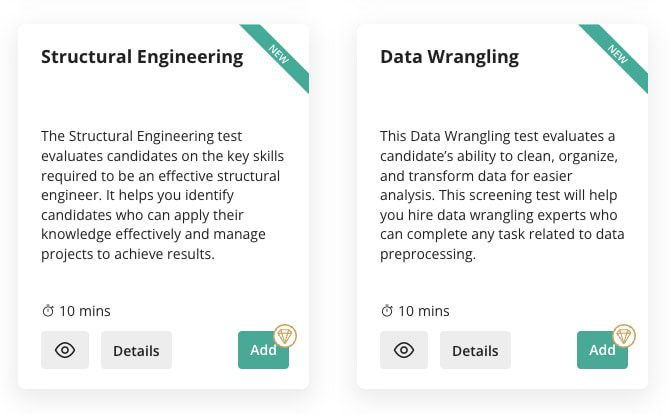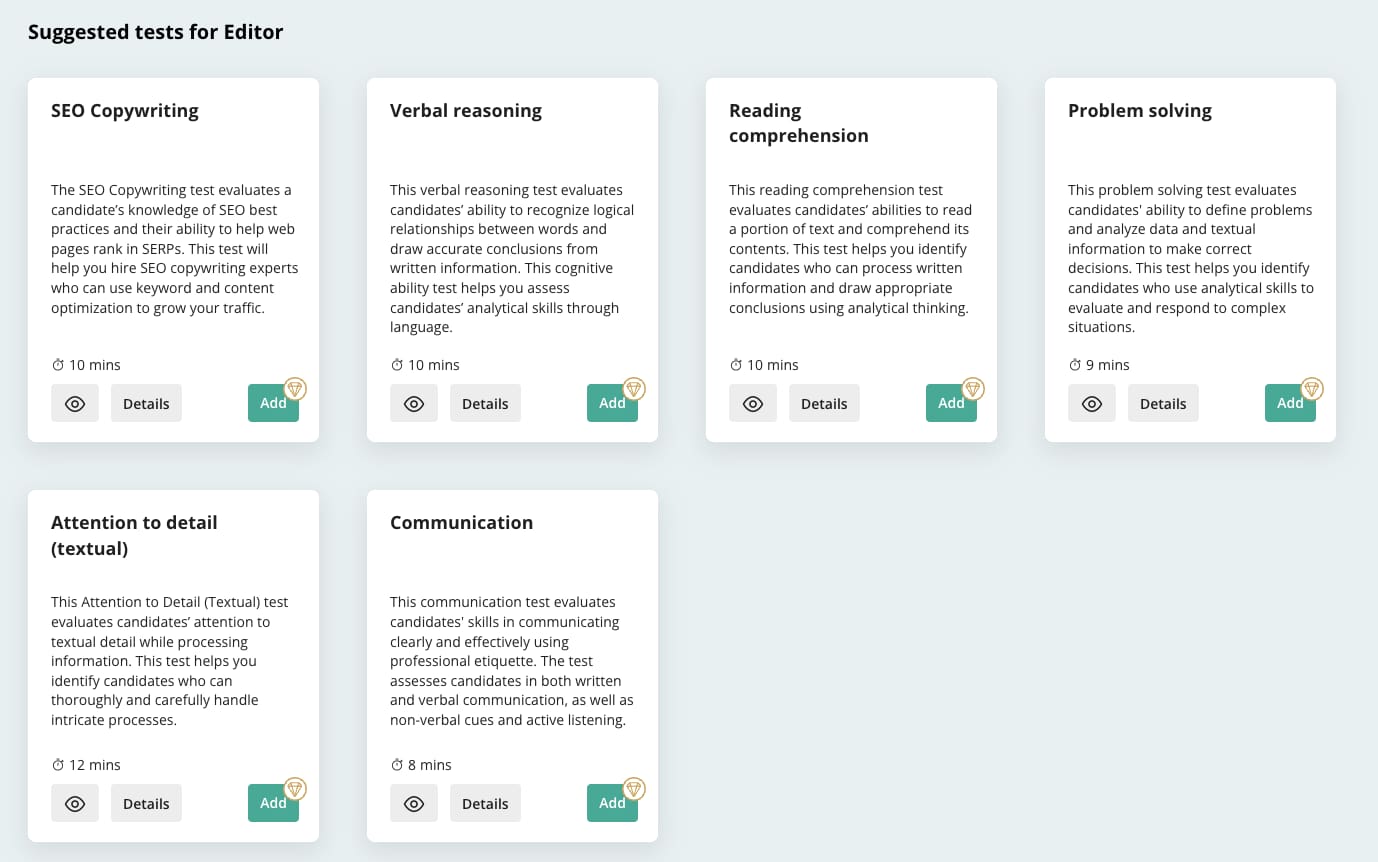Talent pool management: How talent assessments help you build and organize a database of potential candidates
The average time to hire in the US is around 36 days – that’s a long time to wait for new talent to fill open roles.[1]
To make things worse, HR managers are under pressure to boost hiring efficiency. Many turn to talent pools to help; however, you can’t expect a talent pool to provide the best employees on its own.
What if the niche skills you filled your pool with months ago are no longer relevant to your current roles? What if prospects you once considered “ideal” need extensive training?
You risk wasting time, money, and resources without a proper talent pool management plan.
Combining a well-managed talent pool with skills testing finds you candidates who are:
Ready to interview
Keen to learn and develop the skills you require
Reliable culture adds
Likely to stay with your company
Below, we look at the definition of talent pool management and how talent assessments can help you keep your talent pool thriving.
Table of contents
- What is a talent pool?
- What is talent pool management?
- The difficulties with talent pool recruitment
- How talent assessments help build and manage a talent pool
- 7 ways to use talent assessments to optimize talent pool management
- Beyond talent assessments: 3 best practices to remember for talent pool management
- Refill your workforce with skills-based talent pool management
What is a talent pool?
A talent pool is a recruiter's database of warmed-up candidates – individuals interested and invested in working for your company.
When there are job openings in your company, you already have great candidates to contact – in other words, we can say it’s a talent rediscovery tool that saves recruiters time and reduces mis-hire risk.
Talent pool examples include:
Passive candidates who weren’t looking for work previously
Applicants who showed promise during previous recruitment drives
Former staff or potential boomerang employees who know your company well
Current staff looking for leadership development or new challenges
A talent pool is a passive resource. It contains people you’re vetting to join your company but haven’t yet approached.
By contrast, a talent pipeline is an active resource containing people whom you’re already in contact with regarding roles and who are on their way to interviewing and onboarding.
What is talent pool management?
A talent pool management system organizes potential job candidates and ensures their skills remain relevant to your company’s openings.
For example, keeping in touch with talent is important to make sure they're still interested in working with you. Moreover, you need to verify that your talent pool candidates still have relevant and beneficial skills.
Talent pools, company needs, and recruitment standards evolve over time. It pays to build a talent pool and test it regularly, especially during periods of high volume hiring.
Benefits of talent pool management
By managing your prospect pool with skills assessments, you:
Increase pool and workplace diversity
Speed up the hiring process
Reduce pool stagnation
Keep candidates engaged
Discover which skills are most important to your business
A healthy talent pool gives you fast access to people you already know are suited to the roles you’re hiring for.
Failure to manage your pool efficiently potentially increases your time to hire, and you risk hiring poorly engaged staff who quit prematurely.
The difficulties with talent pool recruitment
Managing a talent pool involves more work than simply adding people to an endless pile. To keep your pool efficient, you need to consider:
Diversity levels
Changing skill needs
Industry talent and skills shortages
Pool candidate engagement
Let’s dive into these common talent pool problems.
Diversity levels
The more diverse a talent pool is, the broader your access to potential talent is.
Poorly managed talent pools focusing heavily on experience and demographics risk missing out on potential hires.
Here’s a breakdown of US adults aged 25+ without at least a bachelor’s degree, grouped by ethnic population:
Non-Hispanic White population: 58.1%
Black population: 71.9%
Asian population: 39%
Hispanic population: 79.4%
Talent pools built around bachelor’s degrees as entry-level requirements miss out on the people represented in this data. There’s nothing to suggest these individuals lack the skills companies need – they simply don’t have the educational paperwork – and many could be STARs (workers Skilled Through Alternative Routes).
By using talent assessments and a strong diversity hiring strategy, it’s easy to open up pools to talented people from all backgrounds and support the majority of job hunters.
Changing skill needs
A talent pool left to stagnate probably doesn’t fit a company's current needs in a fast-paced industry.
For example, technical skill demands change rapidly for IT management, coding, and cybersecurity specialties.
Plus, companies blend roles. Employees needed for technical positions often need strong customer service skills, too.
Managing talent pools helps HR keep stock of relevant qualified candidates. Those who aren’t good fits right now can take assessments to stay in the pool in case a suitable role opens up.
Another method is for HR to offer additional training with the promise of a future role consideration.
Industry talent shortages
In a talent shortage, recruiters need qualified, vetted talent in their pools.
Leaving talent pools to stagnate increases the risk of hires becoming "irrelevant" to a company's cause. Candidates also risk dropping away through lack of engagement.
A talent shortage might sound unlikely, given high unemployment rates. However, industries like manufacturing regularly struggle, with more than two million vacancies projected by the end of the decade.
What’s more, millennial employees are fueling the Great Resignation.
Leisure and hospitality firms, for example, are suffering. Up to 21% of millennials left roles during 2021, with poor compensation being a key factor.
Several industries are facing similar headaches thanks to revolving door turnover and poor talent management:
In the face of employee turnover increasing and traditional recruitment processes coming up short, managing your talent pool and keeping potential candidates engaged has never been more important.
Talent pool engagement
It's easy to assume once candidates are in a talent pool, they're there for life. However, these prospects move on, change industries, and lose interest in companies.
Recruiters returning to a talent pool after some time risk finding prospects are no longer interested in applying for work.
To improve candidate experience, checking that their needs and wants align with your own is important. Recruiters should look for ways to help upskill and test talent pool prospects to ensure there's still mutual interest.
Doing so helps HR prioritize high-quality candidates and high-potential hires, or HiPos.
How talent assessments help build and manage a talent pool
Whether you’re taking stock of your current contacts or looking to expand your talent pool, let's cover the basics.
Talent assessments and skills-based hiring principles help you:
Assess and narrow down the skills you need to hire for
Bring internal candidates into your talent pool
Improve hiring diversity
Reduce pool mis-hiring
Assess and narrow down the skills you need to hire for
You need to clearly understand your ideal candidate for your talent pool to function properly.
It’s simply not enough to demand experience and education alone. Other variables, such as culture add and personal motivation, dictate how well prospects fit.
Employers typically find skill validation one of the top three challenges they’re facing – there's even a good chance many struggle to understand the skills they’re hiring for.
The answer is to carefully audit what you need from a position. Skills testing helps HR assess workforces and plan for what they need in future hires.
After testing, you’d look for correlations in results and build custom assessments for potential pool hires. For example, consider customizing personality tests like the DISC assessment.
Identifying the skills you need also reduces the chances of your talent pool stagnating and ensures you judge new hires via the same methods, keeping your pool and hiring efforts inclusive.
Bring internal candidates into your talent pool
It's a common misconception that your talent pool is entirely external. However, nothing is stopping you from building your pool with internal talent.
It’s even quicker to move pool talent who are already onboard with you into positions. They're on contract, are good culture adds, and get up to speed at a fraction of a new hire's processing time.
Lining your talent pool with internal staff helps build a healthy talent mapping strategy.
You become a company that’s clearly invested in learning and employee development.
And there are time and cost savings to consider – with an agile workforce, you can simply move existing staff across your talent maps instead of turning to expensive and time-consuming recruitment drives.
Research shows that a company using skills-based modeling is 57% better prepared than others to adapt to change, likely because they’re relying on the skills of already onboarded workers.
Talent assessments can also help by offering you insights into skills employees don’t use every day – making them easier to spot (and internal recruitment efforts more efficient).
Improve hiring diversity
As aforementioned, the more diverse your hiring scope, the broader your talent pool. When hiring and filling talent pools based on skills, you build a stock of diverse potential hires well suited to specific roles and your company culture.
These employees are also likely to stay with you for long periods, provided you offer development opportunities and appropriate compensation.
Our own research shows us that nine in 10 companies that adopt skills-based hiring practices improve their diversity – which means their talent pools broaden, too.
Reduce pool mis-hiring
It’s wise to avoid filling a talent pool for the sake of filling it. In times of desperation, some recruiters fill their pools with prospects who check only some of the right boxes.
Up to 95% of companies make mis-hires each year. No one's perfect, but the more mistakes you make, the more costs you incur and the more time you spend recruiting from scratch. [2]
Skill assessments ensure you only fill your pool with candidates who fit your needs. According to TestGorilla research, almost 93% of companies using skill assessments reduced mis-hires when they switched to testing.
7 ways to use talent assessments to optimize talent pool management
Here are seven actions you can take to effectively manage your talent pool with skills tests.
Testing techniques for more reliable talent pools
Technique | Summary |
1. Qualify the talent in your pools | Efficiently find the best people for the roles you want to hire for |
2. Conduct a skills-gap analysis | Plan to hire for priority areas in your business where you need the most support |
3. Segment candidates with scoring | Easily match applicants to specific roles based on test scores |
4. Build an ideal candidate profile | Appeal to highly specific candidates and filter out potentially bad hires |
5. Regularly assess your workforce | Prioritize internal talent mobility and use your existing skills base to design a more precise candidate profile |
6. Test for hard and soft skills | Find talented hires with desirable personal qualities that transfer well across all roles, swapping out technical tests for each candidate |
7. Reach out and test your talent pool | Ensure your pool knows you care about them by keeping them engaged and informed for future roles |
1. Qualify the talent in your pools
Instead of relying on resume screening and experience checks, put pool talent to the test. Arrange retests and fresh checks to guarantee everyone’s still on the same page.
Start using tests when building your pool from scratch to qualify the most important aspects of the roles you’re hiring for.
For example, create a custom TestGorilla assessment that focuses on power skills, such as ethics and integrity and attention to detail:
By testing your talent pool, you filter out people who don’t fit what you need. There’s less chance of you falling back on potential mis-hires and taking on candidates for the sake of doing so.
2. Conduct a skills-gap analysis
A skills-gap analysis shows you where your company needs to train and develop people to fill certain roles.
You do this by testing your existing workforce on all the skills you need for running your business and looking for gaps.
You then prioritize testing for these traits when recruiting and filling your pool.
Although you can improve training opportunities in-house to resolve skill gaps, taking advantage of talent assessments empowers you to act quickly and recruit the right external candidates to your pool.
For example, let's assume you are hiring for a highly technical role, but your existing team doesn't show an aptitude for data wrangling, data science, or software engineering. You'd consider using TestGorilla's library to build custom external assessments:
These tests enable you to find potential candidates who score highly in these technical areas – quickly increasing your team’s data expertise.
3. Segment candidates with scoring
Segmenting hires helps you visualize their overall worth to your company. By segmenting, you place people in different categories and sections – i.e., based on technical skill sets or teamwork potential.
However, segmenting without test scoring can be complex and puts you at risk of unconscious bias.
By using multi-measure assessments – testing potential hires in multiple areas, i.e., role-specific skills, personality, culture add, and motivation – it becomes clear which candidates will best fit into specific roles.
Segmenting helps you easily sort and filter hires based on specific proficiencies. You then head straight for role-specific test results when pulling from a talent pool.
For example, you'd look for negotiation scoring as a segment for a sales operative and prioritize this skill alongside other technical and personality scores.
It’s then easy to cross-reference and filter skills for highly specialist roles further down the line.
Companies like Digital Care use skills testing to lean toward segmenting on talent rather than experience. By moving to a skills testing model, Digital Care no longer relies on resumes and experience and has cut down its cost per hire.
4. Build an ideal candidate profile
A surefire way to always fill your talent pool with the best fits for your roles is to create an ideal candidate profile, or ICP.
Your ICP is the perfect candidate. It's someone you'd love to hire and work with since they satisfy all the role's needs and add perfectly to your culture.
ICPs include information about:
Skills
Career goals
Ethics
Culture expectations
Build an ICP by clearly defining roles and responsibilities and creating a custom assessment plan to test for the necessary skills.
By choosing the specific skills desired for the role you wish to fill, you show your applicants exactly what you expect from them. Being clear on the profile you're looking for filters out unsuitable candidates.
Here’s an example of the skills to include as part of an ICP for an editor position:
5. Regularly assess your workforce
Employees come and go, and roles change to fit customers' needs and companies’ long-term plans.
It's wise to keep testing your workforce to see which skills are most useful in the day-to-day.
This strategy helps design assessment plans to bring people into your talent pool. Instead of making assumptions, regularly testing skills gives you concrete reassurance of which aptitudes are a priority.
Regular assessments help you build stronger internal talent pools. Testing staff finds areas for potential upskilling and reskilling, and it helps you move existing employees across your talent map. This way, you prioritize talent already onboard before recruiting again.
Keep an open mind because workforces change over time. For example, the skills you need for a role in January could differ from those needed in July.
Adjust your talent pool tests alongside your workforce's analytics to stave off stagnation. This doesn't have to be a regular strategy, but following up at least twice a year is good practice.
6. Test for hard and soft skills
You should always test talent pool candidates for hard and soft (or power) skills.
Hard skills are those specific to certain roles, such as technical aptitude. Power skills, meanwhile, are more complex to teach.
These are human skills and traits such as critical thinking, intercultural awareness, and teamwork adaptability.
Ideally, test people in and out of your talent pool with the same power skill assessments. Doing so ensures you hire good culture adds and motivated individuals regardless of the roles they apply for.
TestGorilla’s assessment builder provides flexibility for adding and removing technical tests when needed. Consider creating a plan with personality assessments like the Enneagram test, switching out specific technical tests for different roles.
This way, everyone is graded fairly, and testing is kept fast and precise. It's easier to sort talent pools and prioritize who to contact for new roles.
7. Reach out and test your talent pool
Always keep your talent pool candidates engaged. Those left behind are at risk of looking for work elsewhere if you don’t remind them they’re important to you.
Start by creating email lists to reach out regularly to warm talent pool prospects. Go one step further and create a talent community or applicant tracking system.
Sodexo, for example, offers a talent community where candidates are kept informed about different job opportunities. Prospects receive insights into the company’s culture and events, and the brand benefits from warmed-up, passive recruits over time.
Here’s where testing comes in useful. When onboarding people to a talent community or pool, offer them the chance to test their skills and build profiles while waiting for vacancies.
Once vacancies open, reach out to the people who would be a good fit based on their test results.
In this way, you’re helping applicants prove themselves beyond the same, tired resumes – and you already know if you need to reskill and upskill any of them after onboarding.
Beyond talent assessments: 3 best practices to remember for talent pool management
Talent assessment tests offer some great shortcuts to recruiting success, but here are three other must-dos for better talent pool management beyond testing.
Best pool management practices
Tip | Summary |
1. Nurture passive candidates | Remind people who aren't looking for work that you're a good employer to consider in the future |
2. Bring former employees into your talent pool | Reduce hiring time and cost with former workers who are already good culture adds (and who left on good terms) |
3. Lay out clear expectations | Improve candidate experiences and keep the best talent by avoiding hollow promises |
1. Nurture passive candidates
Passive candidates are those workers who aren't looking for a new position right now but align with your ICP. They're assets for your talent pool because their circumstances could change when you need to recruit again.
Recruiting passive candidates isn’t a simple process because it revolves around creating awareness of your employer branding. You need to show these prospects why you're a good employer and why they should apply in the coming months.
Keep engaged with passive prospects through social media, include them in email lists, and use talent communities to your advantage.
Since passive candidates account for up to 70% of the world's workforce, it's wise to keep opportunities open and remind them about your excellent company culture.[3]
2. Bring former employees into your talent pool
Provided you parted on good terms, rehiring former employees is a potential solution to filling roles.
They need little onboarding due to their experience with you, meaning you can reduce hiring costs and ramp time.
It's a misconception that once someone leaves a role, they never return to a company.
Many recruiters fill their talent pools with positive former employees when compensation and development opportunities are appealing enough.
3. Lay out clear expectations
When reaching out to talent pool candidates, make it clear you only interview people if there’s an adequate fit.
Potential hires often feel frustrated by companies who promise potential roles but never follow through. If a candidate is no longer a good prospect for your company, be honest and tell them straight away.
Also, lay out expectations about skill testing – be upfront about the onboarding process from the applicant's perspective.
Refill your workforce with skills-based talent pool management
Having a proactive talent pool management strategy ensures you always have a list of people to call on when hiring gets tough.
Keeping your talent pool engaged and full of relevant prospects also serves you well when hiring at a high volume or speed. Using skills tests tightens up your process even further.
By regularly assessing your candidates and existing workforce, you:
Reduce the risk of hiring inappropriate staff
Cut down time-to-hire
Consistently hire genuinely talented people
Reduce bias in hiring and expand your recruitment net
Of course, before using any new talent pool management software or building assessments, you should revisit your current recruitment strategies – for example, your process when hiring millennials or hiring Gen Z workers.
Also, consider getting acquainted with TestGorilla’s test library for inspiration before exploring skills-based hiring.
Sources
“SHRM Customized Talent Acquisition Benchmarking Report”. (2017). Society for Human Resource Management. Retrieved August 22, 2023. https://www.shrm.org/ResourcesAndTools/business-solutions/Documents/Talent-Acquisition-Report-All-Industries-All-FTEs.pdf
Boulter, Isabel. (March 16, 2022). “Avoid Mis-Hiring: Top 5 Tips for a More Effective People Strategy”. Insights by Virti. Retrieved August 22, 2023. https://insights.virti.com/effective-people-strategy/
“The Ultimate List of Hiring Statistics for Hiring Managers, HR Professionals, and Recruiters”. LinkedIn Business. Retrieved August 22, 2023. https://business.linkedin.com/content/dam/business/talent-solutions/global/en_us/c/pdfs/Ultimate-List-of-Hiring-Stats-v02.04.pdf
Related posts
Hire the best candidates with TestGorilla
Create pre-employment assessments in minutes to screen candidates, save time, and hire the best talent.
Latest posts
The best advice in pre-employment testing, in your inbox.
No spam. Unsubscribe at any time.

Hire the best. No bias. No stress.
Our screening tests identify the best candidates and make your hiring decisions faster, easier, and bias-free.
Free resources
This checklist covers key features you should look for when choosing a skills testing platform
This resource will help you develop an onboarding checklist for new hires.
How to assess your candidates' attention to detail.
Learn how to get human resources certified through HRCI or SHRM.
Learn how you can improve the level of talent at your company.
Learn how CapitalT reduced hiring bias with online skills assessments.
Learn how to make the resume process more efficient and more effective.
Improve your hiring strategy with these 7 critical recruitment metrics.
Learn how Sukhi decreased time spent reviewing resumes by 83%!
Hire more efficiently with these hacks that 99% of recruiters aren't using.
Make a business case for diversity and inclusion initiatives with this data.

